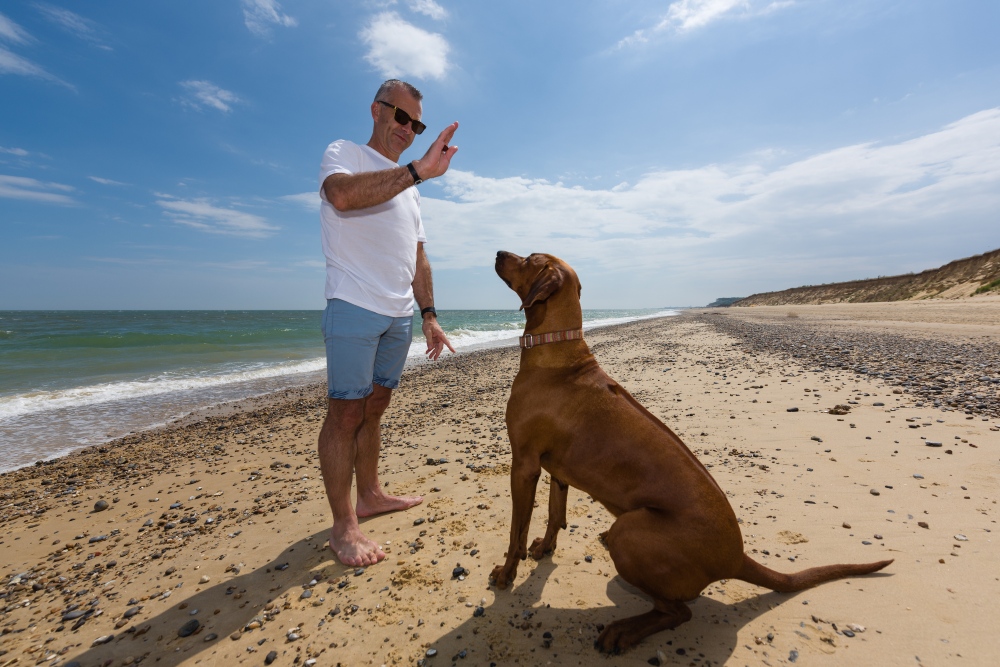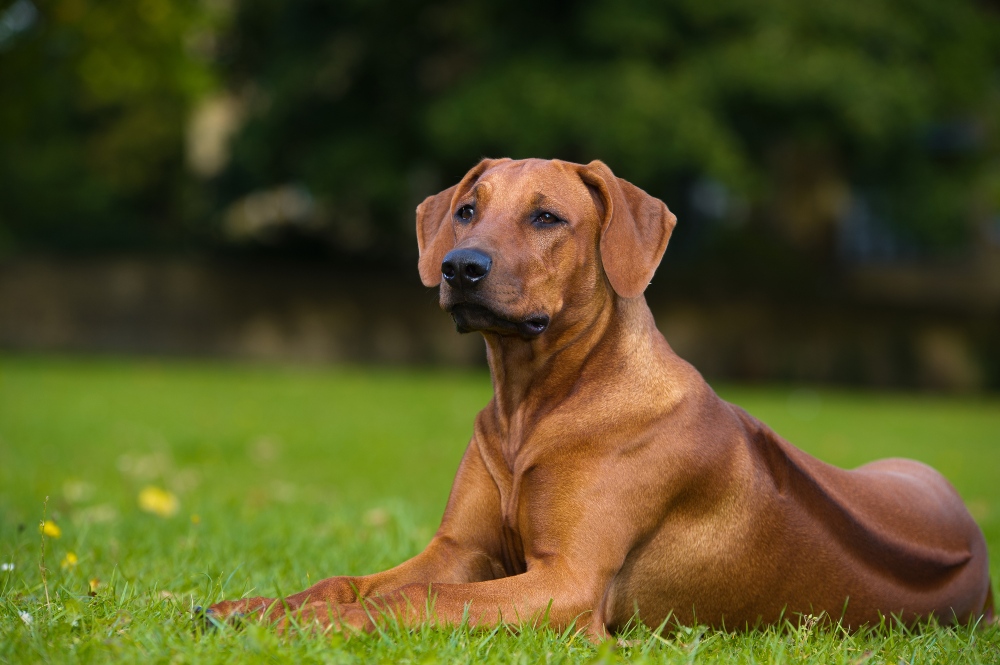Table of Contents
Introduction to Rhodesian Ridgebacks
Large, dignified, and affectionate, the Rhodesian ridgeback is a dog breed with many attractive qualities. These even-tempered and good-natured dogs can be quiet and gentle in spite of their size. They were bred to be versatile hunters and guardians, but they also have a moderate energy level that extends to both lively jogs in the neighborhood and cozy cuddles on the couch.
Native to Africa, the dogs have served many purposes over the years and are wonderful companion dogs today. To learn more about the Rhodesian ridgeback, the breed’s characteristics, and how to take the best care of the dog’s health, keep reading this Healthy Paws breed guide.
Size of Rhodesian Ridgebacks
One of the most defining characteristics of the Rhodesian ridgeback is its size. An adult male dog stands 25 to 27 inches tall and weighs about 85 pounds. The female Rhodesian ridgeback is 24 to 26 inches tall and around 70 pounds when fully grown. It typically takes at least a year or a bit longer for a Rhodesian ridgeback to reach its adult height and weight.
Below is a chart detailing how big you can expect your Rhodesian ridgeback to get as the dog grows from puppyhood to adulthood. Female dog weights are on the low end of this range, and male dog weights are on the high end.
| Weight Chart | 3 months | 6 months | 9 months | 12 months | 16 months |
| Average Weight for Rhodesian ridgebacks | 28-31 lbs. | 55-62 lbs. | 75-80 lbs. | 84-88 lbs. | 88-99 lbs. |

Characteristics of Rhodesian Ridgebacks
Common terms used to describe Rhodesian ridgebacks are strong-willed, independent, formidable, and loyal. These dogs must be trained from an early age so they don’t develop behavioral problems as they get older and stronger. Although these dogs are assertive and protective, they can do well with kids and even cats if introduced from an early age.
You’ll have a faithful friend and affectionate companion when you let a Rhodesian ridgeback into your life, but these aren’t necessarily the best dogs for a first-time pet parent. Other things to know about these dogs is that they are moderately adaptable to different temperatures, easy to groom, and have a high potential for both wanderlust and chasing prey.
As you get to know a Rhodesian ridgeback’s personality, here’s what you can expect based on his or her breed characteristics.
| Breed Characteristic | Level (High, Medium, Low) |
| Affectionate with People | Medium |
| Good with Kids | Medium |
| Good with Pets | Medium |
| Need for Exercise | High |
| Energy Level | Medium |
| Intelligence Level | Medium |
| Able to Be Trained | Medium |
| Amount of Barking | Low |
| Amount of Shedding | Medium |
History of Rhodesian Ridgebacks
The Rhodesian ridgeback’s history originates in southern Africa, where they were bred to be a cross of the native ridged Khoikhoi dog and the European breeds brought over from Dutch colonists. Those breeds included greyhounds and terriers, while the native African dog’s genetics gave the breed resiliency against pests and the ability to outsmart predators.
A Rhodesian game hunter named Cornelius van Rooyen used ridged greyhound-like dogs in his pack of lion dogs in the late 19th century. They were successful at providing protection against dangerous animals in the wild, while also being devoted to their families and affectionate towards children. The dog was originally called the African lion hound. The first Rhodesian ridgeback breed standard was written in 1922, even as big-game hunting was dwindling in South African at that time. A movie star named Errol Flynn first bred the dog in the U.S. on his Hollywood ranch in the 1930s. The American Kennel Club first recognized the dog as an established breed in 1955. Interestingly, the breed is named after the ridge of forward-growing hair on the dog’s back.

Rhodesian Ridgeback Standard Information
According to the breed standard for this type of dog, the general appearance should be strong, muscular, active, balanced, and symmetrical. These are handsome dogs that are athletic and capable of prolonged endurance. They have a dignified temperament, are devoted to their families, and tend to be reserved with strangers. However, the most defining characteristic of the Rhodesian ridgeback is the unique ridge on the dog’s back.
Here is an overview of the breed standard information for Rhodesian ridgebacks:
Head:
- Fair length with flat skull
- Eyes moderately well apart and round
- Ears set high and of medium size
- Long, deep, and powerful muzzle
- Jaws level and strong
- Scissors bite preferred for teeth
Neck, Topline, Body:
- Fairly long neck, strong and free from throatiness
- Powerful and firm back with strong loins
- Strong tail that tapers towards the end
Forequarters:
- Sloping, clean, and muscular shoulders
- Elbows close to body
- Feet compact with well-arched toes
- Tough, elastic pads protected by hair between toes and pads
- Dewclaws may be removed
Hindquarters:
- Clean, well-defined muscles and hocks well let down
- Feet same as in the front
Coat:
- Short and dense
- Sleek and glossy
- Ridge formed by hair growing in opposite of direction of the rest of the coat
- Ridge starts behind the shoulders and continues to hips
Color:
- Light wheaten to red wheaten
- Some white on chest and toes permissible
Gait:
- Back level and stride efficient, long, free, and unrestricted at a trot
- Great coursing ability and endurance at a chase speed
- Balance between power and elegance
Caring for Rhodesian Ridgebacks
Rhodesian ridgebacks need physical and mental exercise every day to prevent boredom and destructive behavior. They are moderately adaptable dogs that can even live in apartments if they get enough daily exercise outside. However, a home with a fenced yard is ideal for this dog so that it has plenty of room to run but is kept safe from jumping over or digging under protective barriers.
Here are some general tips for taking the best care of a Rhodesian ridgeback:
Best Living Environments:
- Houses with fenced yards
- Older children typically okay
- Males should not live with other males due to aggression tendencies
- Not best for first-time pet parents
Type of Exercise:
- Multiple 15-20-minute walks per day
- Playtime in a fenced yard
- Hikes with family members
Mental Enrichment:
- Quality time in the house with family
- Games of fetch in the yard
- Toys to keep the dog busy and entertained
Training Strategies:
- Training requires consistent and firm teaching because these are strong-willed dogs
- Keep on a leash unless in a fenced yard
Grooming Tips:
- Easy to groom coat
- Seasonal shedding for dogs that spend more time outdoors
- Brush with a rubber brush weekly to remove dead hair
- Wipe with a clean cloth weekly after brushing
- Brush teeth daily
- Trim nails once or twice per month

Common Health Problems of Rhodesian Ridgebacks
Fortunately, Rhodesian ridgebacks are generally healthy dogs that don’t see too many health problems during their lifetimes. But for when accidents and illnesses happen, it is a smart idea to have a Healthy Paws dog insurance plan to help you pay for costly veterinary bills.
These are some of the most common health issues that arise with Rhodesian ridgebacks:
- Hip dysplasia
- Elbow dysplasia
- Cataracts
- Hypothyroidism
- Dermoid sinus, a congenital skin defect
Diet and Nutrition for Rhodesian Ridgebacks
Rhodesian ridgebacks should be fed a large-breed dog food that is appropriate for their life stage (puppy, adult, or senior). An adult Rhodesian ridgeback needs approximately 2 3/4 cups to 4 3/8 cups of dry dog food per day, depending on the calorie content of the dog food. Always use label recommendations as a guideline This total amount should be divided into morning and evening meals.
Where to Adopt or Purchase Rhodesian Ridgebacks
Rhodesian ridgebacks sometimes end up in animal shelters because people don’t know what they are getting into before bringing one into their house. There are rescue groups that can lead you to Rhodesian ridgebacks in need of a good home, such as the Rhodesian Ridgeback Rescue, Inc. and Ridgeback Rescue of the United States. The Rhodesian Ridgeback Club of the United States provides rescue resources, as well as links to approved rescue organizations.
If you want to adopt a pure Rhodesian ridgeback from a breeder, check out the AKC Marketplace to find a puppy from an AKC-registered litter.
Related Breeds
Choosing a dog to adopt or purchase is a big decision, so you may want to explore alternative breeds to the Rhodesian ridgeback before bringing one of these dogs into your home. Here are some other breeds that may interest you if you love what you’ve learned so far about the Rhodesian ridgeback:
- Great Dane
- Thai ridgeback
- Boerboel
- Vizsla
- Weimaraner
- Broholmer
- Black mouth cur
- Dalmatian
Pet Insurance for Rhodesian Ridgebacks
The average lifespan of a Rhodesian ridgeback is 10 to 13 years, but you can make the best of each moment with your dog by prioritizing preventive care, giving prompt attention to health concerns, and providing lots of love. Rhodesian ridgeback pet insurance through Healthy Paws covers everything from genetic and hereditary conditions to breed-specific conditions, emergency care, alternative care, and more.
Get your Rhodesian ridgeback health insurance quote today, and feel confident that you can always take the best care of your canine companion.








